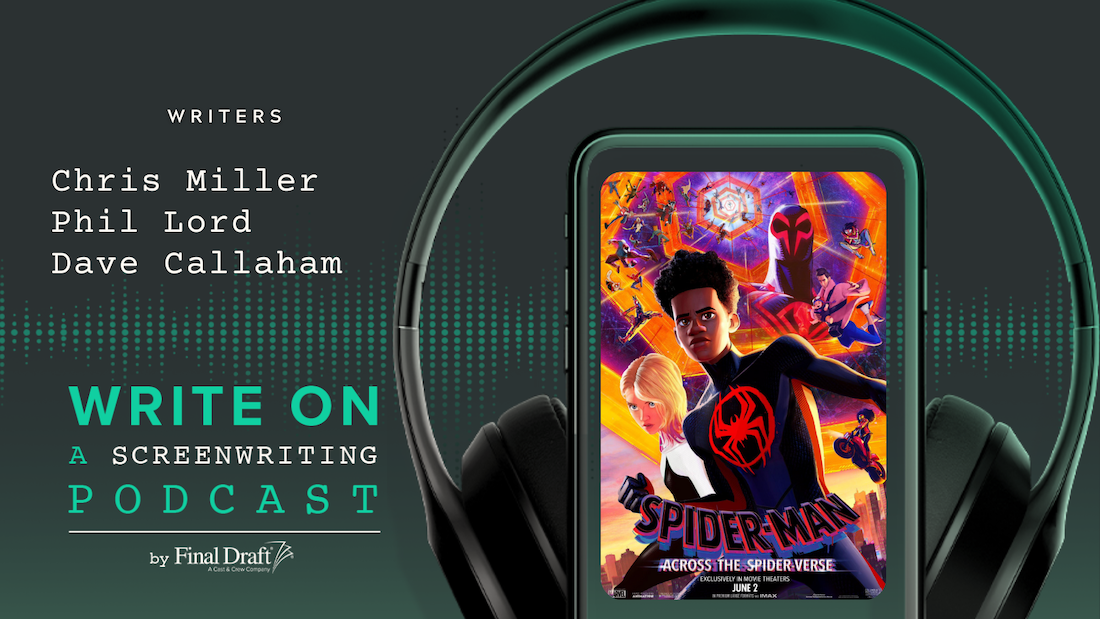All the Write Moves: Spider-Man: Into the Spider-Verse
January 14, 2019
Given the sheer number of Spider-Man movies that have been released since Tobey Maguire gave Kirsten Dunst that upside-down kiss back in 2002, it’s reasonable to wonder whether there’s anything left to say about the iconic Marvel Comics character. The cure for such skepticism is the current animated feature, Spider-Man: Into the Spider-Verse.
Written by Phil Lord and Rodney Rothman from Lord’s original story, Spider-Verse playfully acknowledges Spider-fatigue in many ways. Superficially, the picture addresses the issue with an opening voiceover-driven montage conceding that everyone already knows Spider-Man’s story. On a deeper level, the picture ingeniously presents an alternate-dimension version of Peter Parker/Spider-Man whose life has not gone well. Depressed and lonely following a breakup with his beloved Mary Jane Watson, this middle-aged version of Peter/Spidey has a belly, a temper, and a whole lot of regret.
However, this broken-down superhero is only a supporting character, since the real protagonist of Spider-Verse is teenager Miles Morales who’s poised to become the Spider-Man of his own dimension. Putting Miles together with the broken-down Peter/Spidey allows Lord and his collaborators to explore a whole spectrum of Spider-emotions, so that at any given time, the audience faces cynicism, optimism, and everything in between — all from variations of the same character.
Teamwork Makes the Dream Work
In the same way that Captain America: Civil War (2016) re-energized an overexposed character by situating Spider-Man within the Marvel Cinematic Universe, Spider-Verse places one particular Spider-Man, the Miles Morales version, on a continuum with other Spider-people. Both of these clever storytelling maneuvers sidestep a problem that befell the Andrew Garfield Spider-movies, which retraced the steps of the Tobey Maguire Spider-movies.
In Spider-Verse, Miles derives inspiration from an encounter with his dimension’s first Spider-Man, a younger version of Peter Parker than the broken-down character. Then, once Miles connects with the broken-down Peter/Spidey, Miles recognizes that he must learn from the older hero’s experience. All of this cleverly sidesteps an issue plaguing all previous Spider-movies: since versions of the character played by Garfield and Maguire were loners while in costume, storytelling arcs were predictable. Spider-Man gains his powers, gets the “responsibility” speech from Uncle Ben, suffers a dark night of the soul, then resets his moral compass in time to save the day.
Civil War and Spider-Verse force Spider-Man to play well with others. In doing so, the movies draw out new dimensions of the character. The lesson for screenwriters is that grounding characters within social networks, counter-intuitive as it sounds, allows for deeper explorations of those characters. When writing about a character who spends most of his or her time alone, it’s rewarding to depict behavior and patterns and so forth. But when writing about characters who socialize, you’re able to display those characters from two different angles — how they see themselves, and how others see them.
Takeaway: Community is a prism for reflecting character.
By the Book
Before he gains his Spider-powers, Miles suffers many of adolescence’s familiar indignities — he feels awkward inside his changing body, he’s terrified around the girl he likes, and he resents the weight his parents put on his shoulders whenever they talk about his potential. The script for Spider-Verse offers an efficient signifier for all of this material in the form of Charles Dickens’ 1860 novel Great Expectations. More specifically, the signifier is a book report about Great Expectations that Miles is assigned to write for his English class.
Placed where it is in the story, the reference to Great Expectations functions like a summary for everything we’ve learned about the pressure that Miles feels. So, naturally, he feels blocked when trying to write the paper, because the topic of expectations, great or otherwise, pains him. But then the script adds another layer to the signifier in the form of Miles’ sketchy Uncle Aaron, who takes him to a secret underground spot where Miles can practice creating graffiti. Miles decorates his art with the phrase “No Expectations.” This is Miles’ rebellious way of saying that he wants to chart his own path, but it’s also an expression of profound anguish — as if the idea of having any path at all is overwhelming.
The reason this device works so well in Spider-Verse is that the writers don’t make the reference to Great Expectations do all the work. Instead, they lock and load the signifier before the audience even knows the signifier is on its way, so when the signifier arrives, it feels organic and right.
Takeaway: Cultural references can double as thematic signifiers.
Messages Within Messages
As co-director Peter Ramsey said on stage at the Golden Globes when Spider-Verse won the prize for Best Animated Feature Film, the overt message of Spider-Verse is that anyone could wear the Spider-mask; which is to say that one need not be extraordinary in order to achieve — or at least attempt — extraordinary things. This ties in with an observation that Spider-Man’s co-creator, Stan Lee, made many times during his lifetime. Lee noted that persons of color identified with Spider-Man more than with other Marvel heroes because Spider-Man’s costume obscures the wearer’s entire body. Therefore, an Asian, black, or Latinx reader could imagine themselves inside the costume.
Spider-Verse hits the first note overtly, expressing via dialogue, story, and theme that anyone can become a hero. Yet it hits the second note indirectly. During his introductory sequence, Miles is clearly presented as having biracial identity since his father is black and his mother is Latinx. However, the words “biracial,” “black,” and “Latinx” are never uttered. The film’s message of inclusion is quietly embedded within the film’s message of empowerment.
The insight that any screenwriter can glean from this nuance is that messages need not be transmitted through dialogue. Not every story requires a line as blunt as the classic Spider-saying “With great power comes great responsibility.” Some stories achieve the same impact by presenting deliberately constructed narratives. Throughout Spider-Verse, Miles bonds with Spider-people from different dimensions, one of whom is Asian, two of whom are female, and one of whom is not human. Miles’ opinions of these Spider-people grow from his reactions to their behavior, not from any preconceptions he might have about their ethnic or gender identities.
In this way the movie conveys tolerance through the simple act of putting a tolerant protagonist onscreen. No speeches necessary.
Takeaway: Not every theme needs to be explained in dialogue.
Written by: Peter Hanson
Peter Hanson is a Los Angeles-based writer, filmmaker and teacher. He directed the screenwriting documentary Tales from the Script, and he teaches at Pepperdine University and UCLA Extension. He provides script consulting at www.GrandRiverFilms.com.



